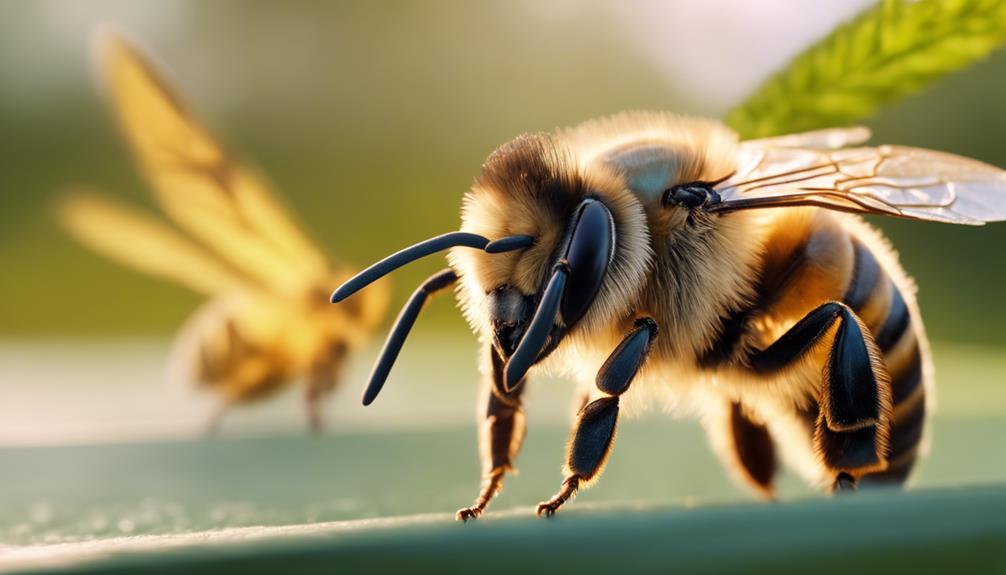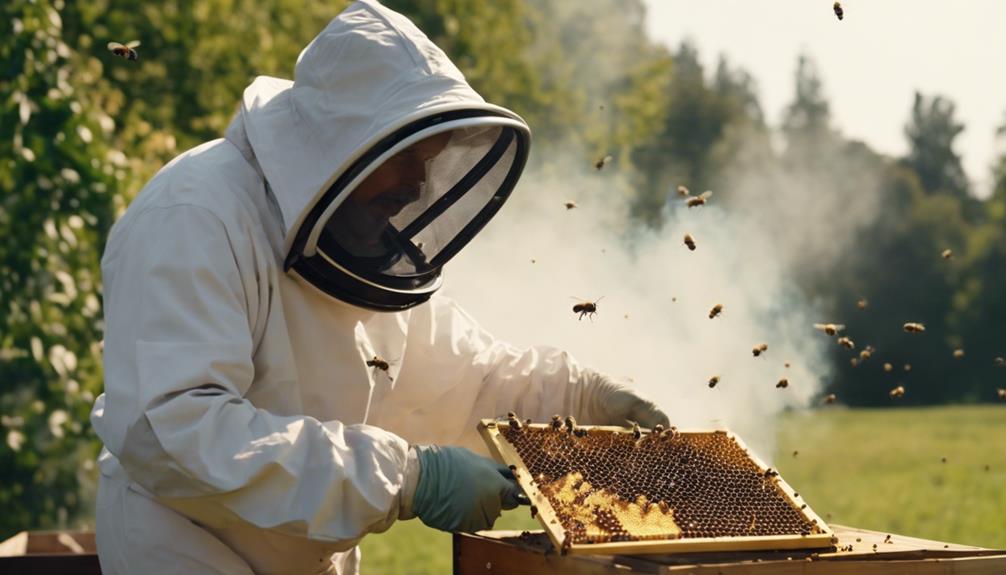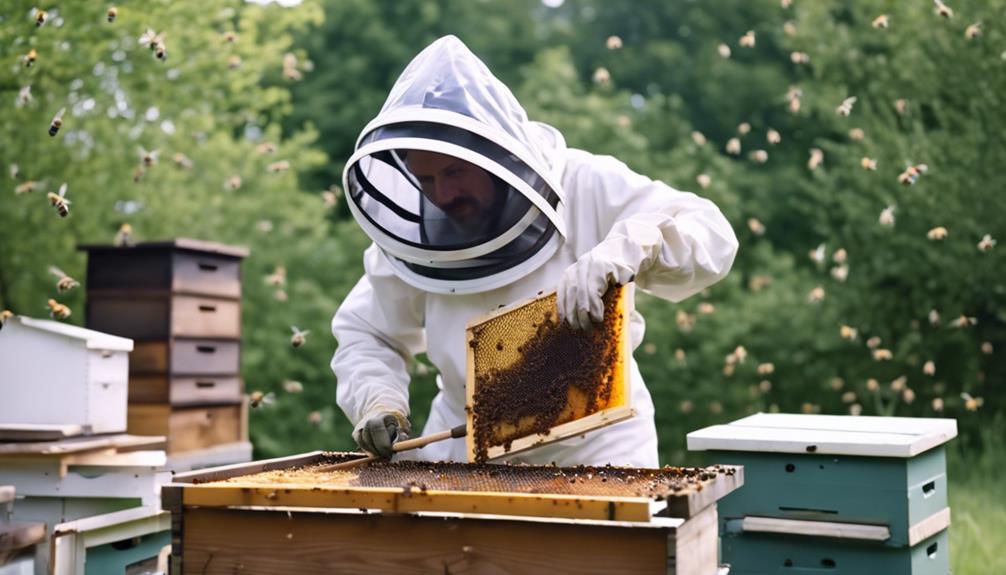So, here’s the buzz about honey bees and worker bees! Honey bees and worker bees are both essential to the hive’s success, but they have distinct roles. Physically, honey bees are larger with interlocking four wings, while worker bees are smaller. Behaviorally, worker bees transition from caring for young to foraging, performing intricate dances, and have specialized glands. Worker bees have a lifespan of 5-7 weeks, contrasting with the queen’s several years. These differences highlight the intricate harmony in the hive. There’s so much more about these fascinating creatures awaiting discovery!
Main Points
- Honey bees encompass all types (queen, worker, drone) in the colony, while worker bees are non-reproductive females.
- Worker bees perform essential tasks like nursing young, foraging, and hive maintenance.
- Physical differences include size contrast and wing morphology distinctions between honey bees and worker bees.
- Lifespan varies greatly, with workers living 5-7 weeks, queens several years, and drones only 2 months.
- Both honey bees and worker bees play vital roles in pollination, ecosystem balance, and hive productivity.
Honey Bee Vs. Worker Bee: Overview
When comparing honey bees to worker bees, it becomes evident that they each play distinct roles within the colony. Honey bees, including the worker bees, form a complex social structure where every member has a specific job to guarantee the hive’s success.
Worker bees, all being female, are the backbone of the colony, responsible for tasks like foraging for food, caring for the young, and maintaining the hive’s infrastructure. Their communication skills are remarkable, using dances and pheromones to convey important information to their fellow bees.
While the term ‘honey bee’ refers to the entire species, ‘worker bees’ are the diligent non-reproductive females important for the colony’s functioning and prosperity. In this intricate society, each bee has a critical role in ensuring the hive thrives.
Physical Differences Between Honey Bees
So, in regard to the physical differences among honey bees, one striking contrast lies in their size. Worker bees are significantly smaller compared to other honey bees like the queen and drones.
Additionally, their wing morphology can also differ, showcasing unique characteristics that set them apart within the hive.
Size Differences
In comparing honey bees and worker bees, one notable distinction lies in their sizes, with honey bees typically appearing larger and more robust than worker bees. When you observe these bees in the hive, you’ll notice the honey bees stand out due to their size.
Queens and drones also showcase size variations within the honey bee colony, with drones being larger than worker bees but smaller than queens. This size difference plays an important role in identifying different bee castes and understanding their roles within the colony.
Wing Morphology
As we shift our focus to wing morphology, it becomes apparent that honey bees and worker bees exhibit distinct physical differences in their wing structures. Honey bees boast four wings that interlock during flight, enhancing their stability and efficiency as they zip around collecting nectar and pollen.
On the other hand, female worker bees sport smaller wings, limiting their aerial abilities but aiding in tasks within the hive like nursing and foraging. The shorter hind wings of honey bees, compared to their forewings, contribute to their precise flight control and agility.
These variations in wing size and structure are vital for the unique roles honey bees and worker bees play in the colony’s intricate social structure.
Behavioral Distinctions of Worker Bees
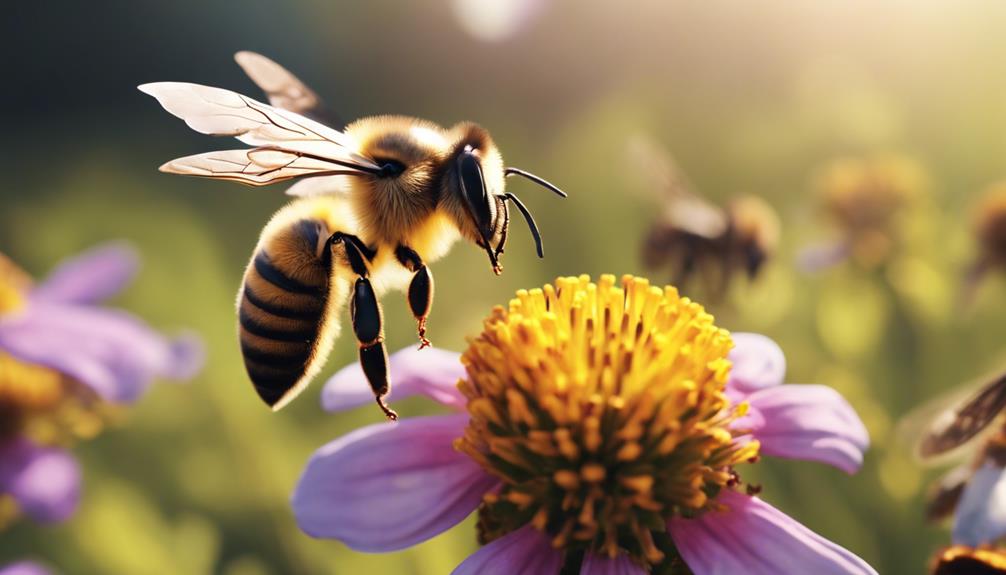
Worker bees play crucial roles within the hive, from cleaning and nursing to foraging for food. As they age, these bees transition from caring for the young to venturing out in search of nectar and pollen.
Through intricate dances and specialized glands, worker bees guarantee the hive’s survival and well-being.
Worker Bee Roles
Engaged in a myriad of essential tasks within the hive, worker bees diligently guarantee the survival and productivity of the honey bee colony. Here are some key roles they play:
- Cleaning Cells: Worker bees meticulously clean and maintain the cells where the larvae develop, ensuring a healthy environment for the young bees to grow.
- Nursing Young Bees: These devoted workers feed and nurture the developing larvae, providing them with the necessary nutrients for healthy growth.
- Collecting Nectar: As they mature, worker bees transition to becoming field bees, venturing out to gather nectar and pollen to bring back to the hive.
Each worker bee contributes distinctively to the division of labor, harmoniously working together for the benefit of the entire honey bee colony.
Work Division in Hive
Within the hive, the division of labor among worker bees manifests through a range of distinct behavioral distinctions that contribute to the smooth functioning and survival of the colony ecosystem. Worker bees transition from house bees to field bees, with responsibilities shifting as they age. Younger workers excel at tasks like nursing, cleaning, and tending to the queen, ensuring the hive’s internal harmony.
As worker bees mature, they take on roles like guarding the hive entrance, protecting their home from intruders. Furthermore, older workers venture out for foraging, diligently collecting nectar and pollen to sustain the hive. This intricate system of work division is essential for the hive’s prosperity, with each bee playing a critical part in the collective success of the colony.
Lifespan Variances Between Bee Types
When considering the lifespan differences between different types of bees, it becomes apparent that each plays an essential role in the hive’s ecosystem. Here are some key points to emphasize these distinctions:
- Worker bees have a relatively short life span of 5-7 weeks, moving from house bees to field bees, taking on different tasks essential for the colony’s survival.
- Queen bees, on the other hand, can live for several years, ensuring the reproduction and stability of the hive.
- Drones fall in between, with a lifespan of around 2 months, contributing to the mating process before their time comes to an end.
Understanding these life span variations is important in appreciating the specialized roles each bee type plays in maintaining the colony’s harmony and productivity.
Reproductive Roles in the Hive
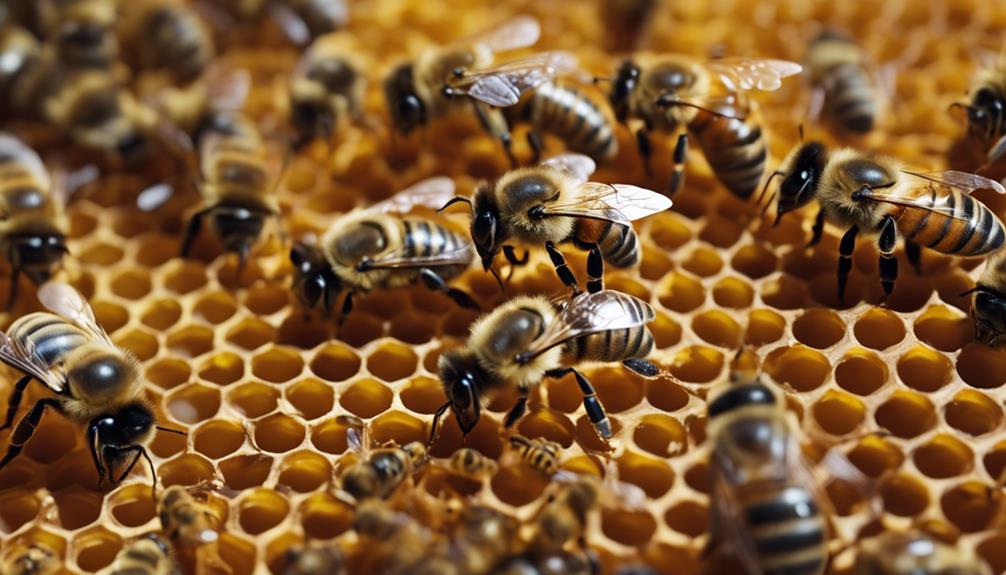
In the intricate social structure of a beehive, the reproductive roles are distinctly divided among the queen, worker bees, and drones. Worker bees, all female, play vital roles in the hive – from caring for the queen to producing honey and pollinating flowers. These busy bees have a short lifespan of around 5 weeks, evolving through different tasks as they age.
On the other hand, drones, the male bees, have a larger body size and mainly focus on mating with the queen. They live for about 2 months and are expelled from the hive by the worker bees to conserve resources.
The queen bee, the matriarch of the hive, lays an impressive 1500-2000 eggs daily, controlling the hive’s population and relying on both drones and workers for hive maintenance.
Importance of Both Bee Types in Ecosystem
Both honey bees and worker bees play important roles in sustaining the ecosystem through their dedicated tasks within the hive. Here’s why they’re essential:
- Pollination Powerhouses: Worker bees are key pollinators, transferring pollen between flowers which is essential for plant reproduction and the growth of fruits and seeds.
- Hive Harmony: Worker bees, being all female, perform a wide array of tasks like foraging, nursing the young, cleaning the hive, and guarding the entrance. This diverse skill set is necessary for maintaining the balance and functionality of the colony.
- Ecosystem Guardians: Through their tireless efforts, worker bees maintain the well-being of the hive, contributing to the overall health of the ecosystem by facilitating pollination and supporting plant diversity.

Roger Thomas is a seasoned beekeeper and hive architect with a deep-seated passion for sustainable living. His fascination with bees has shaped his professional career, giving him practical and theoretical expertise in bee behavior, colony health, and optimal hive conditions. Roger’s technical skills shine in his bespoke hive creations that cater to the specific needs of diverse bee species, while his sustainable practices promote environmental balance and the wellbeing of the bee population.
As he continues his journey in beekeeping, Roger has become a dedicated advocate for responsible practices and an insightful educator in his field. His posts aim to inspire new beekeepers, underline the importance of sustainability, and showcase the remarkable contribution bees make to our ecosystem. Roger invites you to join him as he delves into the world of bees and the rewarding, honey-sweet art of beekeeping.
